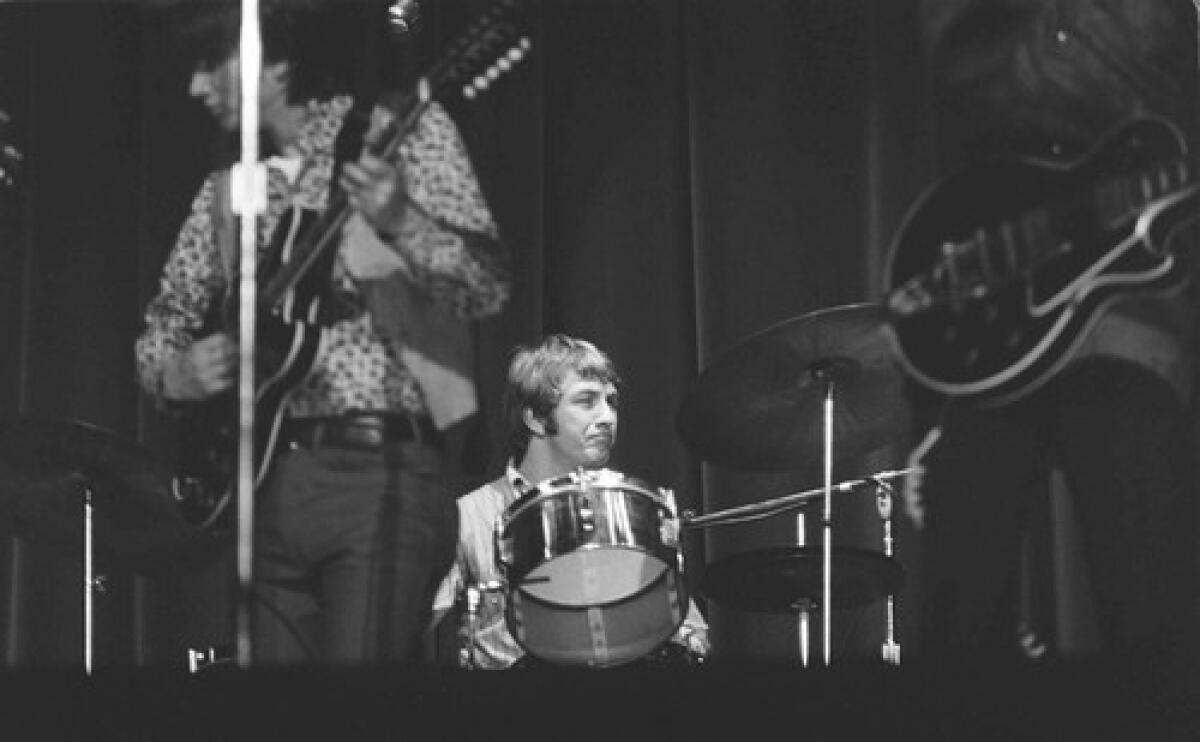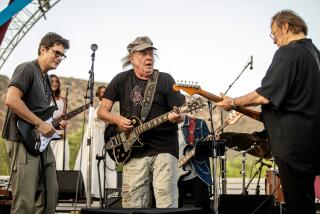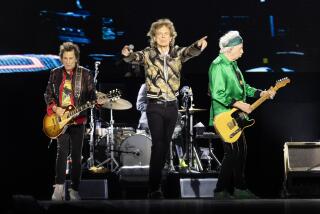Dewey Martin dies at 68; drummer for Buffalo Springfield

Dewey Martin, drummer for the short-lived but long-resonating rock band Buffalo Springfield whose career after the group split never ignited like those of his former band mates Neil Young and Stephen Stills, has died. He was 68.
He was found dead Sunday by a roommate in his Van Nuys apartment, longtime friend Lisa Lenes said Thursday. The cause of death has not been determined. âWe believe it was natural causes,â Lenes said, adding that he had suffered health problems in recent years and performed publicly only sporadically.
FOR THE RECORD:
Dewey Martin: The obituary of Buffalo Springfield drummer Dewey Martin in Fridayâs California section gave the title of the song âFor What Itâs Worth (Stop, Hey Whatâs That Sound)â as just âFor What Itâs Worth.â â
Martin was one of the founding members, along with Young, Stills, singer-songwriter-guitarist Richie Furay and bassist Bruce Palmer, of Buffalo Springfield, a key progenitor of country-rock music. The group existed for just two years and recorded only three studio albums before disbanding amid rising tensions and musical ambitions of the bandâs talented but explosive leaders.
In his autobiography âShakey,â Young praised Martinâs musical sensitivity. âYou get harder, he hits harder. You pull back, he hits back. He can feel the music -- you donât have to tell him.â
âItâs a great loss,â Micky Dolenz, drummer for the Monkees, said Thursday. Dolenz said he became close friends with Martin in the late â60s when both were working in and around Hollywood. âWe never worked together, we just hung out a lot. We went to shows together at the Whisky and the Troubadour. He was a great drummer -- itâs a well-known fact. And he was a really nice guy.â
Martin played on Buffalo Springfield songs including âFor What Itâs Worth (Stop, Hey Whatâs That Sound),â âMr. Soul,â âRock âNâ Roll Womanâ and âBroken Arrow.â He was inducted into the Rock and Roll Hall of Fame as a member of the group in 1997.
âHe didnât want to go to the induction,â Lenes said. âBut I told him, âYou need to be there, you need to be acknowledged.â When I saw him on TV, it was so great.â
When Buffalo Springfield broke up, Young launched a solo career thatâs still going strong 40 years later; Stills moved on to Crosby, Stills & Nash (and sometimes Young) and Furay formed Poco, another early country-rock outfit. Martinâs fortunes remained closely tied over the years to his time with Buffalo Springfield.
FOR THE RECORD:
An earlier version of this article gave the title of the song âFor What Itâs Worth (Stop, Hey Whatâs That Sound)â as just âFor What Itâs Worth.â
He first began performing as the New Buffalo Springfield with other musicians. âWe have a more powerful sound . . . thatâs the way I would compare it with the old group,â Martin told the Oakland Tribune in 1969. âBefore it was east-going country-western. Now weâve added some electronic sound devices and Jim Price on amplified trumpet and trombone.â
Stills and Young successfully sued to prevent him from using the name without their participation. Nevertheless, in the mid-â80s, he and Palmer toured as Buffalo Springfield Revisited, and for a time in the â90s Martin played shows as Buffalo Springfield Again, mostly in the Southland at venues such as the Taste of Newport in Newport Beach.
Guitarist Rick Corradini backed Martin as part of a pickup band for some of those shows. âHe was a great guy and seemed as enthused to play with us bunch of guys as he was to play with those other hotshots,â Corradini said Thursday.
Martin was born Walter Milton Dewayne Midkiff on Sept. 30, 1940, in Chesterville, Canada, according to Buffalo Springfield scholar Nick Warburtonâs Sixties Rock Archive website.
He moved to the United States looking for work as a musician and played on sessions in Nashville in the early-â60s. Even though Young and Palmer were also Canadians, they didnât meet Martin until all had migrated to Los Angeles to take part in the burgeoning folk-rock scene here that was spearheaded by the Byrds.
Young, Stills and Furay had crossed paths previously, and when they reconnected in L.A. in 1966, they decided to start a new band. Within days of starting rehearsals with Palmer, they brought in Martin to handle drums. Nine days later, they opened an arena show for the Byrds in San Bernardino.
Byrds founding member Chris Hillman recently recalled touting the group to Whisky A Go-Go co-founder Elmer Valentine the first time he heard them, which led to a residency at the club that helped launch Buffalo Springfieldâs career.
Atlantic Records founder Ahmet Ertegun quickly signed the group to his label at a time when he was trying to expand its roster into rock after years of focusing primarily on R&B, soul and jazz.
The group wasnât a huge popular success at the time -- the highest any of its original three albums charted was No. 42, and âFor What Itâs Worthâ -- which includes the line âStop, hey, whatâs that sound?â -- was its biggest hit, peaking at No. 7 in 1967. But the groupâs songs, mostly written by Stills and Young, but also including some of Furayâs, have become an enduring part of the classic-rock canon.
Outside of his Buffalo Springfield incarnations, Martin formed several other groups, including Medicine Ball, which released one album that failed to chart. In recent years heâd worked on developing a new type of drum head.
Lenes said Martin would be buried in Canada at his familyâs request, and that plans for a memorial service in the Los Angeles area were in the works. Information on his survivors was not immediately available.
More to Read
Start your day right
Sign up for Essential California for the L.A. Times biggest news, features and recommendations in your inbox six days a week.
You may occasionally receive promotional content from the Los Angeles Times.






